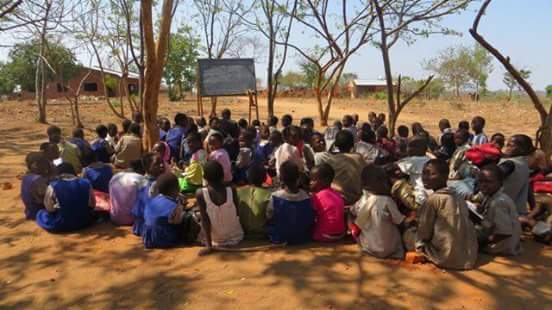
We have heard a lot about schools under trees locations where children study in next-to-nature conditions.
I once witnessed a school under a tree somewhere near Kavululanga in Mzimba district. It was a large shady tree.

There was a tired blackboard leaning against the tree that is why those categories of schools are called schools-under trees. It can be any tree. But I guess it should be a tree that is situated somewhere in close proximity to habitats so children can walk short distances to and from school.
Some of the children sat on stools they had brought from home; and some sat on anything that could be sat on — on the floor. Some of the children played around, without any focus whatsoever on learning.
The teacher looked like a God-sent woman who was just doing God’s precious work, out of deep love for humanity. She stood there with love in her eyes, trying to impart knowledge to the playful, mostly inattentive children.
This casual school was just something to occupy the time of the children whilst their parents did whatever parents do when they can take a break from their kids.
As I walked away from that school under a tree, some key issues rushed through my mind. When the kids have to respond to nature’s call, how do they handle their matters?
The answer that came to me was: in the bushes or wherever. After all, open defecation is allowed and tolerated in Malawi.
Another issue that continues to trouble me about schools under trees and other deprived schools, which are located in funny structures, is: how do they study Information Communication Technologies (ICT), the newest kid on the block of knowledge sharing? But more specifically, what do the teachers know about ICT?
Without electricity, without tables, without chairs and worst of all, without motivation, how are children who are dealt such low blows early in their lifetimes to compete with children who attend real schools?
If your school structure is at the mercy of natural—wind, tropical rainfall, and unmentionable creepy things — what would you become in future as you either drop out or finish school?
What does it even mean to ‘finish school’ when you can’t read and write—and without arithmetic and ICT?
On a lighter note, whilst children are in an under-tree school, if an aeroplane passes above, they do not have to make any effort to sneak out of their classrooms to watch—when they feel like it. All they have to do is to raise their heads, look up, ignore the already tired teacher, and feast their eyes on the plane and wonder—what is out there beyond the clouds—far far away.
And when they grow up, the least chance they will get, they will relocate to the bright city lights of Blantyre to become hawkers. And whilst in Blantyre Malawi’s commercial city, they will hope and pray for a chance to flee from Malawi.
Story of Kavululanga basic school in Mzimba north
‘Pupils of Kavululanga Basic School in the Mzimba North now learn under baobab -frond roofed sheds because of inadequate classroom blocks.
The school, which started as a community initiative in 1970’s and absorbed into the mainstream during the government of Dr. Bakili Muluzi in 1994, is now in a life-threatening state with visible cracks on parts of the school building.
‘The roof of the only building housing the pupils was ripped off some four years ago following a rainstorm. This compelled the authorities to move the upper primary pupils to the already crowded junior primary school block whiles the rest are accommodated under the sheds.
‘In 2004 there was an intervention by the community to provide some classroom blocks following an increase in enrolment. This intervention however could not meet the present demands as pupils were seen lumped in the dilapidated structure.
‘Some teachers, who would not speak on record, said they are compelled to close down the school when it rains. “We don’t want the building to collapse on us and the innocent children, so the best way is to close the school when it is about to rain.”
‘Kavululanga primary school is among schools in the Mzimba District benefiting from the Mary’s Meal school feeding program. The pupils sit on the bare ground under a tree and under unhygienic conditions to eat meals served under the school feeding program.
The caterers in the school say they had to make “improvises” due to inadequate infrastructure. Malawi24 checks at the Kavululanga revealed that the plight of the school has not been captured into any of the Council’s development plan.
Kavululanga, solve this problem for the learners
John Chisi a resident in the nearby village said, “This Kavululanga Basic School under baobab -fronds sheds, where the kids are at the mercy of nature, could just be the tip of the iceberg on the state of schools on the blind-side of our country.”
What I know is unacceptable in 54 year-old Malawi is that there should be no trees under schools, schools inside trees, schools under trees, schools under palm-fronds sheds or any other such permutations.
On a larger level beyond Kavululanga, we must ponder over the following: Has this country produced more children than it can provide for, especially to give them good basic education, which can situate them well in life? If so, then we must immediately embark on population control initiatives and cut down on the number of human beings we continue to fill up this land with.














